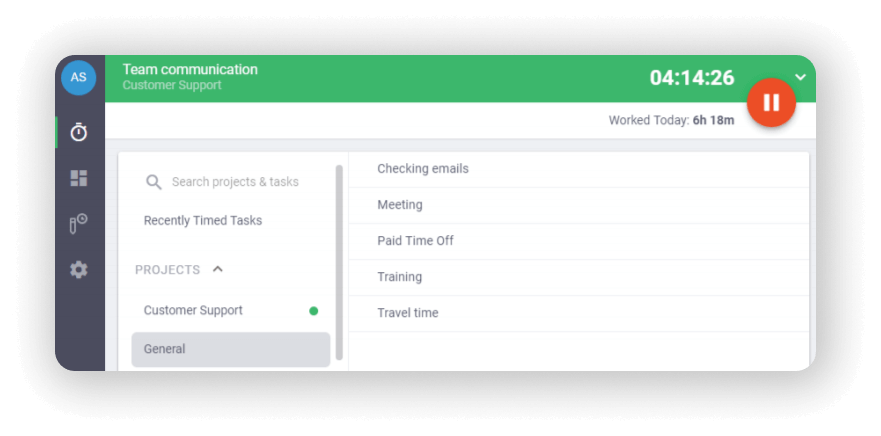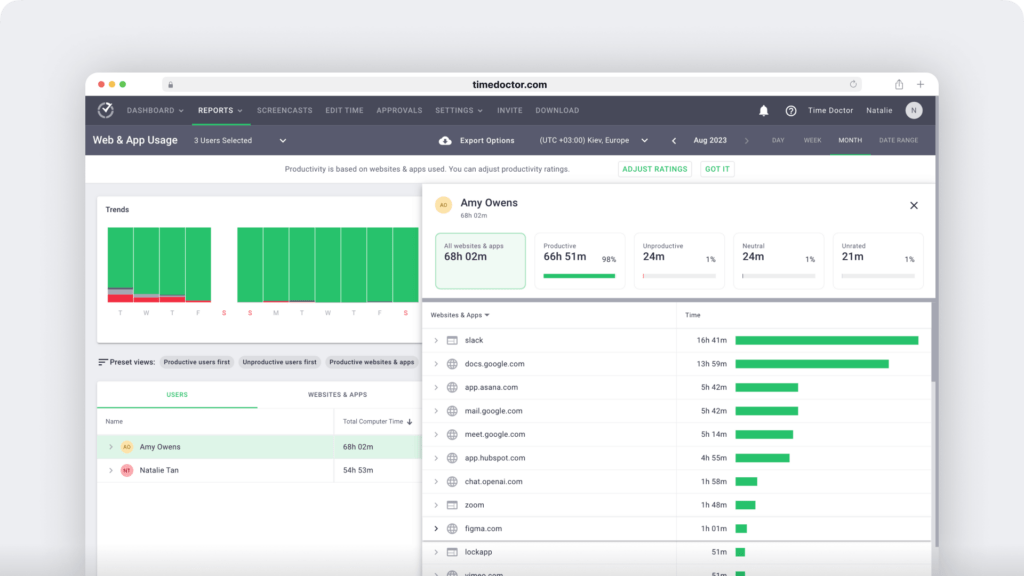Time audit involves tracking and analyzing what you spend your time on for a consecutive number of days. This helps you schedule tasks efficiently, accomplish your targets, and boost productivity.
But how do you perform a time audit?
In this article, we’ll cover what a time audit is and how to perform it with a simple step-by-step guide.
We’ll then highlight four simple ways to enhance time management post time audit along with four FAQs. And as a bonus, we’ll introduce a robust time tracking and productivity tool you can start using today.
Table of Contents
- What is a time audit?
- How to run a time audit (a step-by-step guide)
- 4 simple ways to improve time management post time audit
- Top 4 time audit FAQs
- Time Doctor: A robust time tracking and productivity tool
Let’s get started.
What is a time audit?
A time audit involves recording and analyzing how an individual spends their hours throughout the day.
Tracking time over a period of time for several days can give you a better idea of how you are spending your time. You can then analyze the audit log to see how you are actually spending your time against how you planned to spend your time.
And consequently, you can eliminate time-wasters to create more space for more important ones – enhancing productivity and efficiency.
You also get a piece of valuable information about the time spent waiting for inputs needed for executing work tasks, also known as idle time. Every minute you’re idle is a lost minute and has a negative impact on productivity.
But aren’t you wasting more time doing this additional activity?
No!
The audit process is a short activity that can last up to a week. Once it ends, you can adjust your schedule based on the results.
So, when you plan your day smartly, you’re boosting your efficiency and productivity – saving time in the long run.
Let’s now take a detailed look at how to conduct a time audit.
How to run a time audit (a step-by-step guide)
Here’s a step-by-step guide to run a time audit that’ll help you track your daily activities:
Step 1: Create categories
The first step would be to create categories for tasks that you’re sure will take up most of your day.
For instance, you can create categories like:
- Checking or sending emails, instant messages, etc.
- Meetings.
- Programming.
- Phone calls with key stakeholders.
- Commuting.
Step 2: Define your intentions
Maintaining a record of what you intend to achieve and then comparing it with the audit results will provide a measure of how productive you are. That’s why before you look at any data, you should note down what your ideal day would look like.
And now that you have your defined categories, write down the time you would like to spend on each of them.
For example, if you’re a software engineer, your defined intentions could look something like:
- Coding: 40% of the time.
- Debugging: 20% of the time.
- Client and team communication: 10% of the time.
- Documentation: 5% of the time.
Note: Time management is all about being realistic. These intentions don’t necessarily have to add up to 100% of your time as there’s always a block of time that you can’t control.
Step 3: Track your daily activities
The next step is to track your day-to-day tasks.
Here are three ways to track your daily activities:
- Write down using pen and paper.
- Create logs in a digital note.
- Use a time tracking tool.
The audit log doesn’t need to provide a detailed description of each task.
For instance, you can simply write the word “email” to record the time spent checking your inbox or create a task in your time tracking tool for the same.
Step 4: Set reminders to record your tasks
There’s a fairly high chance that when you’re focusing on your task, you can forget to record your activities – especially at the start of the time audit process. This can lead to inconsistencies in the process and impact the results.
That’s why you need to think of a way to remind yourself to record your data. You can set the alarm on your phone or use an online alarm tool that alerts you with a sound or sends a visual alert.
Additionally, you can also determine the frequency of these alerts.
Step 5: Analyze the results
Lastly, you should review your audit report with a discerning but non-judgmental eye.
Try to note any patterns like:
- Are you spending way less time on a task than you previously thought?
- Do you tend to slack during certain times of the day?
- Is there a specific task that’s draining your time?
Let’s say you’ve recorded spending 15 minutes looking at email every hour. This means it’s taking a significant amount of time that could otherwise be used on other productive tasks.
Now that you have analyzed the time audit results, what should you do next? Let’s find out!
4 simple ways to improve time management post time audit
Here are four no-nonsense tips to improve your time management skills:
1. Reorganize your day
Once you have a log of how you honestly spend your time, the next step is to reshuffle your day to increase its efficiency:
A. Eliminate or delegate tasks
Usually, we perform time-wasting activities at unplanned moments throughout the day.
So, if you’re wasting a lot of time scrolling through social media, either eliminate it or schedule a small amount of time once a day.
Additionally, if you have tasks that can be handled by a secretary or team member, try to delegate them.
B. Consolidate tasks
If you spend multiple time blocks per day on the same or similar tasks, consider consolidating them into one scheduled activity.
For instance, if your time audit reveals that you’re checking your inbox too often, try allocating two specific times per day to check your email uninterrupted.
C. Break large projects into small targets
When you have high-priority activities, it’s better to break them into smaller, manageable goals rather than approaching them without a plan.
Once you have laid out a roadmap, you can assign them to specific time blocks throughout your day. Knowing what to do will allow you to complete them faster.
2. Plan and prioritize
After identifying where time is being used, make a plan to prioritize your most important tasks and eliminate non-productive activities.
Consider using an Eisenhower matrix to prioritize your work based on urgency and importance so you can use your time more wisely.
The matrix is divided into four quadrants:
| Urgent | Not Urgent | |
| Important | Do Do these tasks right away. | Decide Designate a specific time to do them. |
| Not Important | Delegate Delegate if possible. | Delete Set these aside to do later or eliminate them. |
Let’s say most of your time should be spent writing code, make coding your top priority. And make non-productive activities like checking social media the lowest priority or eliminate it.
3. Make changes to your schedule
With a clear idea of your priorities, you can now create a daily schedule that reflects how you want to spend your time.
You can use time management methods like time blocking or simply set up a morning routine for your most important activity.
Having a schedule will give you complete control of your time. This way, you can work on your task with full focus, enhancing productivity.
Check out these 10 time management strategies to make some effective changes in your schedule.
4. Track progress and stay consistent
Now that you have a plan in place, the next step would be to commit to the changes you’d like to make.
But remember to not overwhelm yourself by committing to too many changes at once. Start by selecting just one new habit and track your progress in implementing that change over the next month or two.
You can also set up an accountability partner like a friend or coworker, use a commitment device, or even track your progress and streaks on a calendar.
Still have some doubts about time audit?
Let’s check out some frequently asked queries.
Top 4 time audit FAQs
Here are four frequently asked questions about time audit:
1. When should you do a time audit?
You can run a time audit at any point in time.
However, it’s more effective if you have at least a few weeks or a month of personal data before you get started.
You can also run a time audit if you’re:
- Never able to cross off everything from your to-do list.
- Constantly missing deadlines.
- Spending longer than necessary on specific tasks.
And once you’ve completed your time audit, you can conduct the next one after three months or a year, depending on what you aim to accomplish.
Additionally, avoid conducting a time audit when you’ve tons of work to do or when you’re taking a vacation, as it might not provide beneficial information.
2. How long should you run the time audit for?
This depends on your personal preference. You can do this exercise for three days, five days, a week, or even a month.
The idea behind this process is to get an accurate account of how you usually spend your usual working hours.
3. How frequent should the reminder be?
If you’ve allotted an hour for checking your emails and responding to them, you can set the alarm for each hour. However, if an hour is too long or too short, you can choose whatever time interval you prefer.
Additionally, while choosing a frequency, you should keep in mind that getting too many reminders can make you insensitive towards it, leading to missed or ignored reminders.
For instance, setting alarms for every 30 minutes for five days in a row can soon become overwhelming.
That’s why it’s better to adjust your methods as you learn what works best for you.
4. What tools do you need to perform a time audit?
The tool you decide to use can depend on:
- How you’re used to tracking time.
- The level of detail you want in your audit.
- The span of the time audit.
Here are three types of tools that you can use:
A. To-do list
A to-do list can give you a clear idea of the daily tasks you aim to complete or work on. You can use to-do list tools like Todoist or Wunderlist to track how you spend your days.
However, a to-do list can only provide limited details. Let’s say you have an entry Task A and you spent two hours on it. But how much time did you actually spend working on it?
B. Calendar
Calendars give an account of how you wanted to spend your workday and what got in the way, like meetings or appointments.
Google Calendar and Outlook Calendar are some great online calendars that you can use. But you’ll need to set it up manually every day and make changes to account for urgent or unplanned tasks.
C. Time tracking software
A time tracking app provides a detailed account of how you spend your time on tasks, projects, apps, or websites.
Using a tool makes it easy to track your activities. All you’ll need to do is enter time stamps for each task and it’ll automatically generate timesheets.
Moreover, some tools like Time Doctor even provide timers to make time tracking easier. Just create a task and press the button to start tracking time.
Plus, the best part is that you can continue using this tool post time audit to keep track of your progress. And if you’re an employer, you can even extend it to your employees to manage and boost their productivity.
But wait, what is Time Doctor?
Time Doctor: A robust time tracking and productivity tool

Time Doctor is an excellent productivity management and time tracking tool used by SMBs like Thrive Market as well as large firms like BBB (Better Business Bureau) to boost productivity.
This tool is available on multiple devices and platforms, including macOS, Windows, Linux, and Android.
1. Time tracking
Time Doctor’s time tracking feature lets you track employee activity and hours during the workday.
To track time manually:
- Create a task or choose one from the task list.
- Select the Play button to begin tracking time for the task.
- Simply click on the Stop button once you’ve completed your task or if you want to take a break.

Time Doctor also offers an automatic time tracker that tracks work hours with minimal impact on a user’s daily routine. You can configure the timer to run as soon as you start your computer or during specific hours.
2. Idle time tracking
When there’s no activity, i.e., it detects no keyboard or mouse activity for a defined interval, the idle time tracking feature puts them on a break. It then sends an idle time pop-up to prevent employees from getting distracted.

Note: Time Doctor doesn’t record keystrokes during activity monitoring to maintain employee privacy. It only tracks if any keys were pressed.
3. Productivity reports
With Time Doctor’s detailed productivity reports, employers can get an insight into their team’s productivity and time usage.
Some of these reports include:
- Activity summary report: View a user’s active, unproductive, manual, and mobile time for a selected time period.
- Timeline report: Shows the time a team member spends working and on breaks in daily and weekly formats.
- Projects & tasks report: See the time an employee spends on different projects and tasks.
- Web & app usage report: Lists the sites and applications employees use during work hours and their time on each of them.

4. Powerful Chrome Extension
Time Doctor’s Chrome Extension integrates with 50+ tools to streamline time tracking and boost collaboration.
Simply install the browser extension and configure your desktop app to track time right from the tool you’re using.
Some of the popular tools it integrates with include:
- Project management: Zoho Projects, Trello, etc.
- Customer support: Freshdesk, Zendesk, etc.
- Communication and collaboration software: Zapier, Slack, etc.
- CRM: Pipedrive, Zoho, etc.
Check out other tools that you can integrate with Time Doctor.
Also, explore other amazing features of this powerful tool.
Wrapping up
The goal of a time audit is to do more in less time.
Go through the article to learn how to conduct it the right way. Also, use the tips to create an action plan and amp up your time management skills.
And while you can use any tool for auditing, you should use a time tracking tool like Time Doctor to get accurate results. Its features like time tracking, idle tracking, and productivity reports offer you a detailed summary of how you spend your workday.
So why not sign up for Time Doctor and run your time audit today?

Vaishali Badgujar is a seasoned Content and SEO specialist who provides ROI-focused managed SEO services. She is dedicated to helping businesses connect with their audience online and see real growth through her work.


